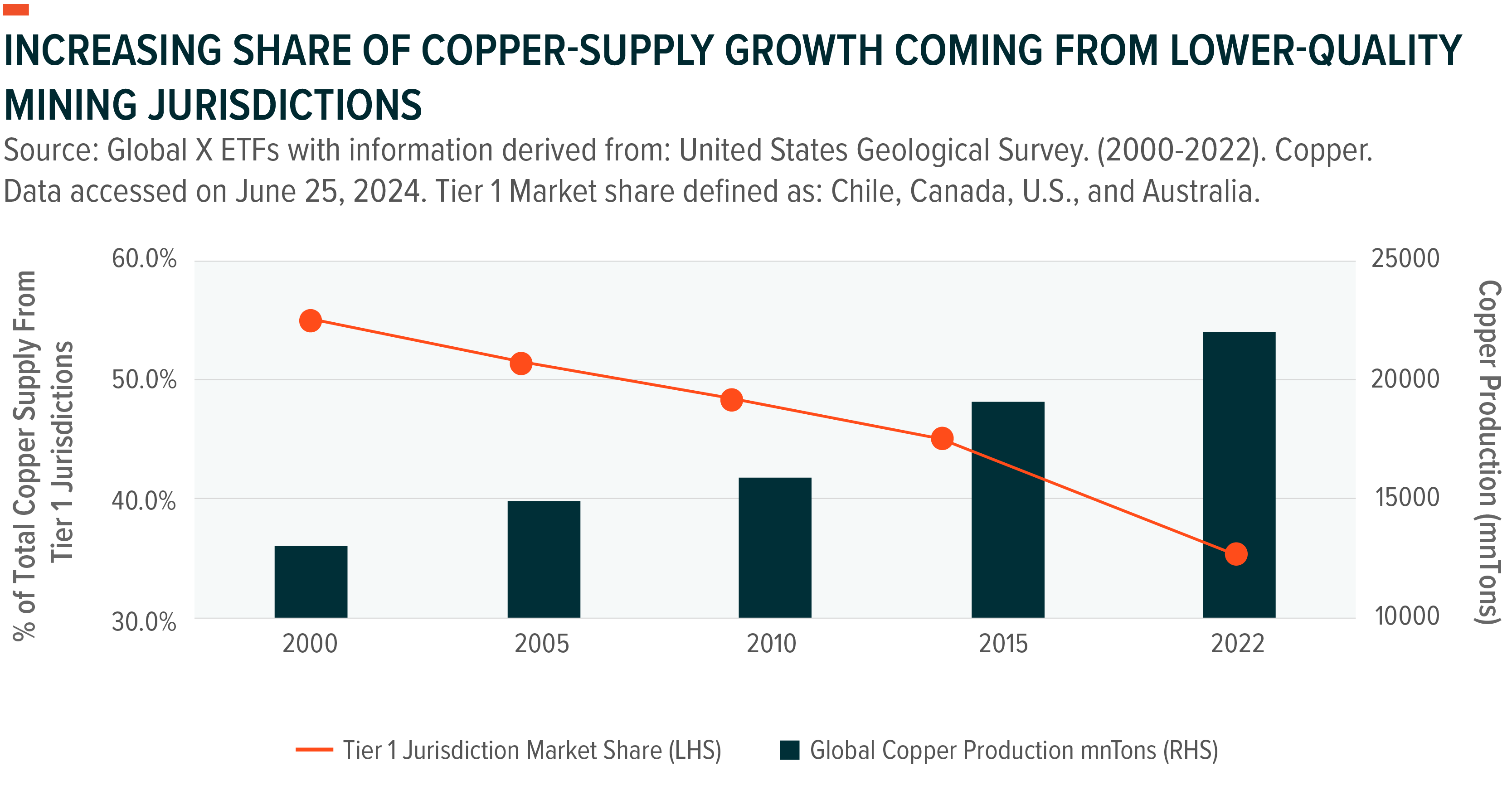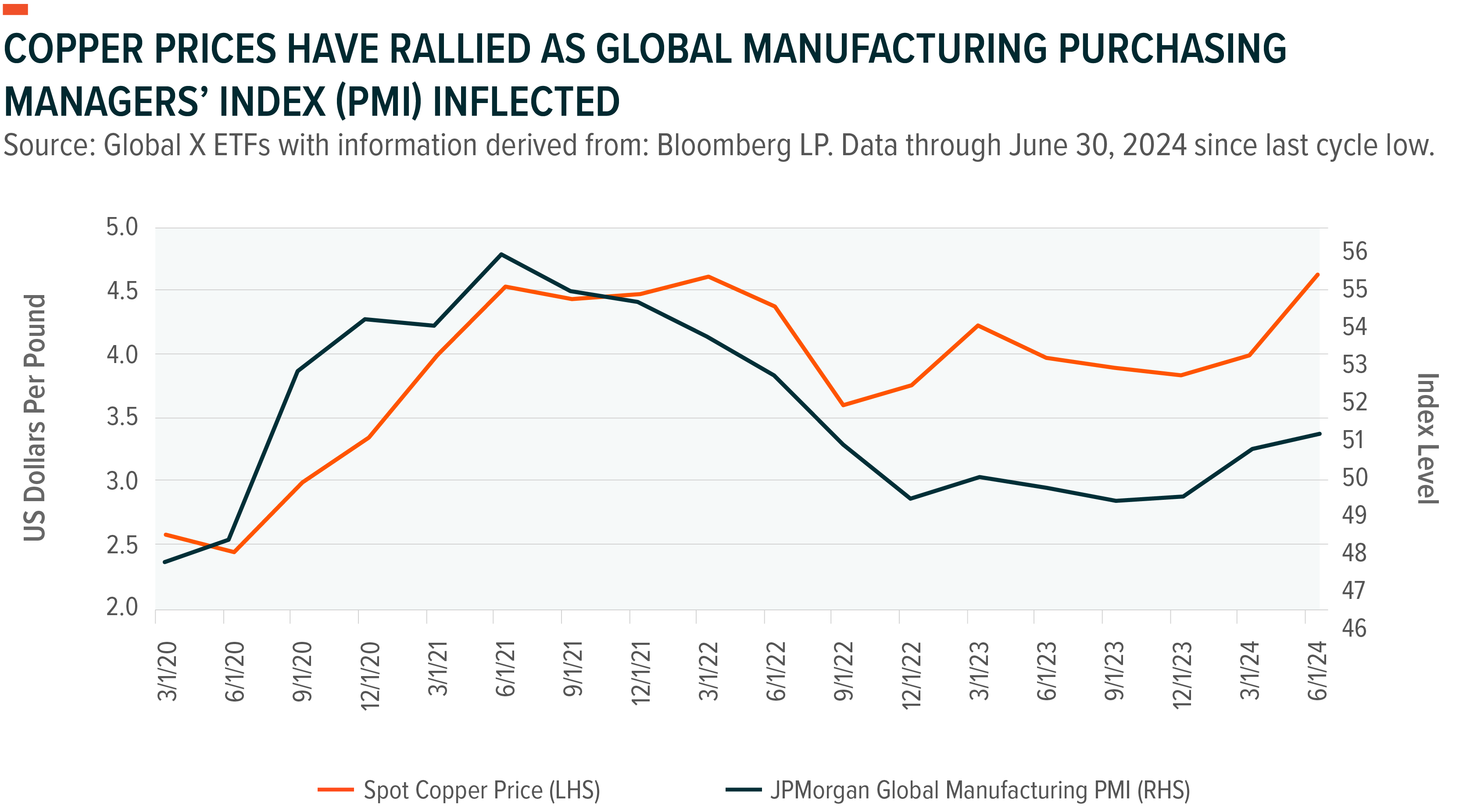Copper: Potential long-term tailwinds meet a cyclical opportunity
Copper has long been associated with cyclical and macroeconomic trends, with demand for the metal and, subsequently, prices, being highly correlated with global economic growth.(1) However, the world is changing and so too are copper’s supply/demand dynamics. Although cyclical trends and global economic growth will probably always play a large role in copper demand, the energy transition, mass electrification, and the rise of artificial intelligence, along with the requisite energy infrastructure investments that come with them, appear to be long-term, structural drivers of demand. This could result in an ongoing situation where supply struggles to meet demand, creating opportunities for miners.
Key takeaways
- The increasing need for energy and subsequent grid buildouts from megatrends such as electrification, urbanisation, and artificial intelligence present a potentially powerful tailwind for copper demand and could reduce the metal’s cyclicality over time.
- Global copper supply appears unlikely to meet the accelerating demand outlook, potentially resulting in higher prices over the medium to long term.
- The rebound in global industrial and manufacturing activity could provide a meaningful boost to copper demand in the short term.
Copper demand appears set to become more structural
Copper’s role in the world is changing, with the industrial metal likely to be a key enabler of the energy transition. Traditionally, copper’s main uses have been tied to construction, transportation, and machinery, making demand historically very correlated with the global economic cycle. China, and specifically its property sector, has traditionally been a large consumer of copper, being a driver of the “super cycle” witnessed at the start of the century. However, we believe the future demand outlook for copper will be increasingly different from the past. New trends such as electrification, urbanisation, and artificial intelligence, and the subsequent grid buildout and power generation investments that these technologies will likely require, could increasingly become a larger share of the overall demand picture. Outsized demand growth outside of China is also expected moving forward, likely offsetting any potential further weakness in copper demand from that nation’s property sector. We do recognise that a large percentage of demand will likely remain cyclical, but this structural shift could result in reduced demand volatility, especially during times of slower economic growth.

Does the world have enough copper to meet demand?
Given copper’s robust demand outlook, we believe it is fair to assume a supply-side response. Be it from substitution, increased scrap utilisation, or investments in new projects, rising demand will likely push prices higher and increase investment into the sector. However, we do not see these supply responses meeting the robust demand outlook over the medium to longer term. The main reason for this is the declining economics around investing in new projects. Many of the most attractive projects, be it from a country risk, ore quality, or cost perspective, have either been or are in the process of being developed. As a result, this lack of new, quality assets forced miners to look at less attractive projects or to less favourable mining jurisdictions, with the share of global production from the four highest quality jurisdictions (Chile, Canada, the United States, and Australia) falling over the past 22 years through 2022.(2) Going into lower quality jurisdictions often comes with increased political and regulatory risks, higher capital intensity due to the lack of infrastructure, and increased risks of social unrest. Furthermore, rising inflationary pressures during the COVID-19 pandemic and its aftermath not only lowered margin expectations but also greatly increased up-front capital expenditures.(3) This increase in upfront costs, along with the higher cost of capital globally, significantly lowered return expectations when evaluating a new project. As a result, we expect copper miners to require a higher long-term incentive price when evaluating new projects, weighing on the supply response and adding to the scarcity value for existing miners who possess longer-term production profiles.

Probably still in the early innings of a global cyclical recovery
Copper’s longer-term price outlook appears robust, with its growing participation in structural megatrends and the challenging supply outlook not only setting the stage for potentially elevated prices, but also likely to set a higher floor for prices throughout the economic cycle. Looking at the market currently, we still see upside potential from cyclical demand moving forward, and we are seeing evidence of this in the data. Specifically, after remaining in contractionary territory for 16 straight months, the JPMorgan Global Purchasing Managers’ Index (PMI) has now been in expansionary territory for six straight months through June 2024.(4) Despite this accelerating trend, global PMI remained well below the previous cycle high of 55.(5) seen in the second quarter of 2021, suggesting additional runway for increased copper demand.5 The physical concentrate (the raw material used by copper smelters) market setup is also interesting for miners, with the increase in global smelter capacity putting the market short of concentrate and driving treatment charges to historically low levels.(6) We expect this to remain a tailwind for miners, while a rebound in the global industrial cycle could result in increasing refined copper demand. We also believe that the recent copper rally is in the early innings (despite a slight pullback in June), with the global industrial economy likely to continue reaccelerating. Although the copper spot price hit a record high this year, it was a record in nominal terms only. On an inflation-adjusted basis, the 2024 peak is still more than 25% below the previous cycle’s 2011 peak.(7)

Past performance is not a reliable indicator of future performance
Conclusion
All in all, we see copper as a potentially attractive opportunity in commodity markets, where the long-term outlook meets a cyclical opportunity. We view miners as particularly interesting, with the market likely to remain undersupplied on concentrate, while the diverging supply and demand trends could potentially result in increased scarcity value. We also remain optimistic about the short-term outlook, despite the recent pullback in copper prices, believing a cyclical inflection could support prices.
Learn more
The Global X Copper Miners ETF (ASX: WIRE) invests in a global basket of copper miners which stand to benefit from being a key part of the value chain facilitating growth in major areas of innovation such as technology, infrastructure and clean energy.

1 topic
1 stock mentioned
1 fund mentioned


